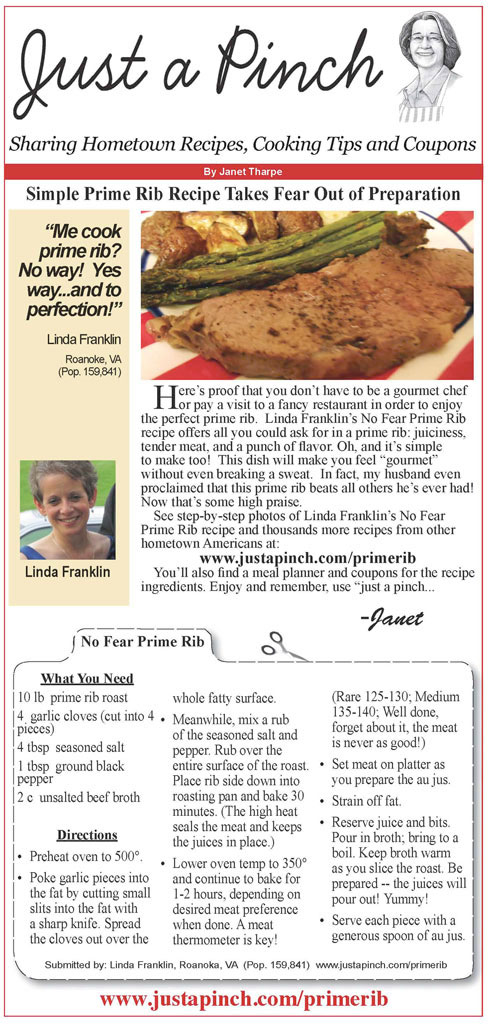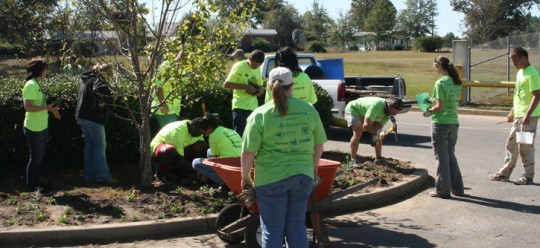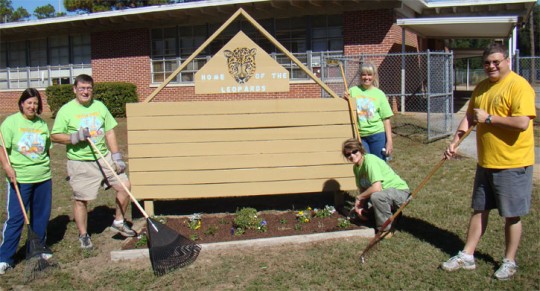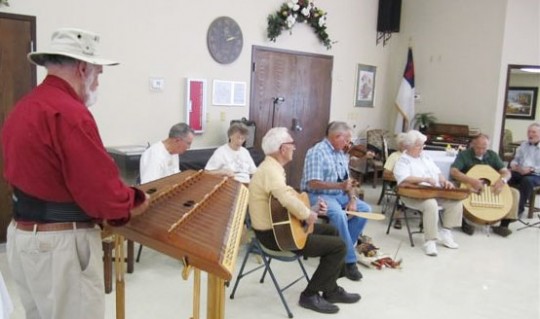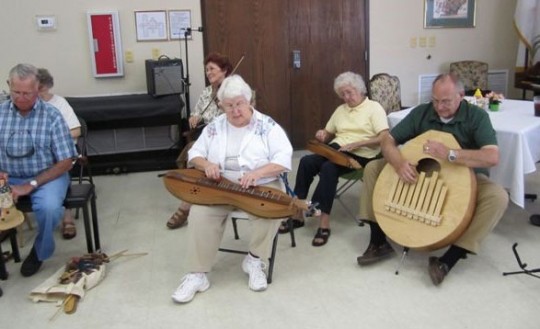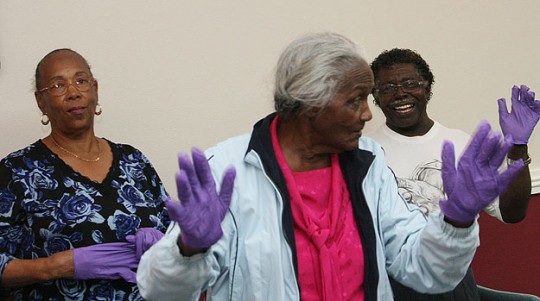Photos: Williams Station Day
October 24, 2010

Thousands attended the annual Williams Station in Atmore on Saturday.
For a photo gallery, click here.
Pictured above: Crowds at Saturday’s Williams Station Day in Atmore. Pictured below: The reunion of the “Kool Tools” band, a popular local band formed in the 1960’s. NorthEscambia.com photos, click to enlarge.
Featured Recipe: Prime Rib – Without The Fear
October 24, 2010
This weekend’s featured recipe from Janet Tharpe is a Simple No Fear Prime Rib. This dish will leave you feeling “gourmet” with tender meat a punch of flavor.
To print today’s “Just a Pinch” recipe column, you can click the image below to load a printable pdf with a recipe card.
Robots Teach Kids; Tate Takes ‘Blood, Sweat And Duct Tape Award’
October 24, 2010

Cheering fans, blaring instruments, and pounding drums — you may think of a football or soccer game. But this is no sports event. It’s a game of the future.
On Saturday morning the University of West Florida Field House buzzed with activity and the Emerald Coast BEST Robotics competition whirred to a start.
The futuristic competition plays out in an arena setting complete with referees, cheerleaders, mascots and cheering students. A deafening din fills the air as 21 area high schools and middle schools compete with their robots, all a part of an initiative to inspire students to pursue careers in engineering, science and technology. Gulf Power Company is the major sponsor of BEST — Boosting, Engineering, Science and Technology.
 This year’s theme, “Total Recall,” is a word play on quality control. In the competition, students will control their robots to successfully process and package as much “good” product as possible while striving for Six Sigma quality levels on each production line. Some products may be identified as “defective” and will be “recalled.”
This year’s theme, “Total Recall,” is a word play on quality control. In the competition, students will control their robots to successfully process and package as much “good” product as possible while striving for Six Sigma quality levels on each production line. Some products may be identified as “defective” and will be “recalled.”
It’s all a part of an initiative to inspire students to pursue careers in engineering, science and technology through participation in a sports-like, science and engineering-based robotics competition each fall. Student teams are judged on robot performance, marketing presentation, team exhibit/interview, project engineering notebook, and spirit and sportsmanship.
Josh King, eleventh grader from Escambia High School, said the competition helped him realize how important science and math are to the real world.
“To get ready for this you have to use the whole engineering design process,” said King. “It starts with brainstorming, then design, then prototype and then final product. We really had fun out there.”
King plans to pursue an Architectural Engineering degree at the University of West Florida.
King’s teacher and lead for the Robotics Club Bob Rainey said BEST helps get the students excited about science and math.
“They have to apply their skills in math and science and engineering,” said Rainey. “This is something really authentic the students can get involved with. BEST Robotics prepares them because everything in life is going to be a project for them, and they’re going to have to overcome problems.”
 Max Levesque (pictured left), a sixth grader and part of the team from Workman Middle School that won first place in the robotics competition, said involvement in robotics had given him a greater interest in math.
Max Levesque (pictured left), a sixth grader and part of the team from Workman Middle School that won first place in the robotics competition, said involvement in robotics had given him a greater interest in math.
“This is something different than what I usually do in school,” said Levesque, “I actually kind of like math more now.”
Introduced by two MIT students, BEST — Boosting Engineering Science and Technology — has grown into a nationally recognized competition challenging more than 50,000 participants since its start in 1993.
Area schools have been competing since 2004, when Gulf Power sponsored eight local teams in the regional competition in Mobile. Twenty schools across Northwest Florida participated in the regionals, and the top schools will advance to competition at Auburn University.
Students had six weeks to build their robots and teams were judged on robot performance, oral presentation, table display, project notebook, spirit and sportsmanship.
Four schools in Northwest Florida were among the winners that will advance to the finals at Auburn University on Nov. 18 – 20: Woodlawn Middle School, Bethlehem K-12, Workman Middle and Woodham Middle.
BEST Award
1. Woodham Middle School
2. Woodlawn Beach Middle School
3. Seaside Neighborhood Middle School
Gulf Power- Blood, Sweat and Duct Tape Award
Tate High School
Robotics Award
1. Workman Middle School
2. Bethlehem K-12
3. Milton High School
4. Woodham Middle
Best Team Website
Seaside Neighborhood Middle School
Best T-shirt Design
1. Hobbs Middle School
2. Sims Middle School
3. Woodham Middle School
Founders Award for Creative Design
Seaside Neighborhood Middle School
Most Robust Robot
Workman Middle School
Most Photogenic Robot
Merritt Brown Middle School
Most Elegant Machine
Milton High School
Best Team Exhibit and Interview
1. Holley Navarre Middle School
2. Woodlawn Beach Middle School
3. Merritt Brown Middle School
Best Marketing Presentation
1. Woodham Middle School
2. Holley-Navarre Middle School
3. Woodlawn Beach Middle School
Best Project Engineering Notebook
1. Bethlehem K-12
2. Woodlawn Beach Middle School
3. Seaside Neighborhood Middle School
Best Spirit and Sportsmanship
1. Woodham Middle School
2. Seaside Neighborhood Middle School
3. Sims Middle School
Courtesy photos for NorthEscambia.com, click to enlarge.
Day Of Caring Works On North Escambia Projects
October 23, 2010
Friday, over 100 volunteer teams took part in the annual United Way Day of Caring in Escambia and Santa Rosa counties, including projects at Northview High School, Jim Allen Elementary and the Cantonment Senior Center.
At Northview High School, volunteers from Exxon Mobil joined the school’s horticulture class in a campus cleanup and planted flowers.
At Jim Allen Elementary, volunteers from Publix sanded and repainted several pieces of playground equipment.
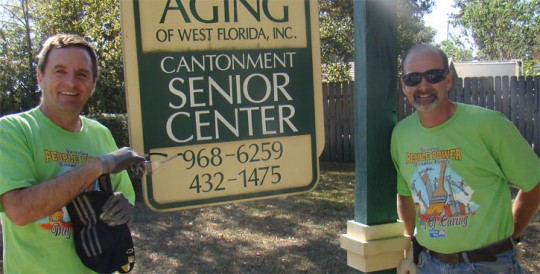 At the Cantonment Senior Center, volunteers from Gulf Power Company washed the outside of the building, painted the front porch and cleaned up the facility’s yard.
At the Cantonment Senior Center, volunteers from Gulf Power Company washed the outside of the building, painted the front porch and cleaned up the facility’s yard.
Volunteer projects across the two counties included yard work at homes of elderly or disabled residents, repair of playground equipment at children’s centers and schools, planting gardens and grounds beautification at schools and nonprofit outreach centers, and help building a Habitat for Humanity home.
Friday marked the 18th year of the United Way Day of Caring in Escambia County. There will be more than 90 projects completed in Escambia County and more than 30 projects in Santa Rosa County, with over 1,100 volunteers taking part.
Pictured top: Volunteers work to beautify the campus at Northview High School in Bratt. Pictured below: Day of Caring volunteers at Jim Allen Elementary School. Pictured inset: Volunteers at the Cantonment Senior Center. Submitted and NorthEscambia.com photos, click to enlarge.
Photo Gallery: Flomaton Hurricane Homecoming Parade
October 23, 2010
The Flomaton High School Homecoming Parade rolled through Flomaton Friday afternoon.
For a complete NorthEscambia.com photo gallery from the parade, click here.
Pictured above: The Flomaton Hurricane band marches in Friday afternoon’s homecoming parade. Pictured below: The FHS class of 2000 shows their Hurricane spirit. NorthEscambia.com photos, click to enlarge.
Flomaton Celebrates Fall, Hurricanes
October 22, 2010
Characters of all sorts roamed the streets of downtown Flomaton Thursday night during the town’s annual Fall Festival. The event also included a big homecoming pep rally for the Flomaton Hurricanes.
The Fall Festival began a weekend of activities as part of the 2010 Flomaton Great Homecoming. Events continue with a homecoming parade and homecoming football game on Friday and a full day of activities on Friday. Click here for more information.
Submitted photo for NorthEscambia.com, click to enlarge.
Over 100 Work To Clean Up Area Waterways
October 20, 2010
Over 100 people recently worked to clean up over 35 miles of North Escambia area waterways.
The cleanup was part of the Alabama Coastal Cleanup across several Alabama counties as well as Escambia County in Florida.
 The largest group participating in the event was organized by Jerry Fischer and friends from Century. The group cleaned over 35 miles of shoreline in Alabama and Florida along the Escambia River, Conecuh River, Little Escambia Creek, Big Escambia Creek, Bluff Springs, Pollard and Murder Creek.
The largest group participating in the event was organized by Jerry Fischer and friends from Century. The group cleaned over 35 miles of shoreline in Alabama and Florida along the Escambia River, Conecuh River, Little Escambia Creek, Big Escambia Creek, Bluff Springs, Pollard and Murder Creek.
Adults and students from the Century, Jay, Brewton and Flomaton areas participated. The youngest volunteer was Chance Thornton, Fischer’s 5-yard old grandson. Century Mayor Freddie McCall personally donated the use of a garbage dumpster for the group.
This international Coastal Cleanup event serves as a public service as well as an educational tool to help teach both adults and students the grave effects that littering has on our environment, specifically to aquatic life, according to area organizer Janet Wofford. Since Alabama joined the International Coastal Cleanup in 1987, over 58,000 have volunteered for the event and over 1 million pounds of trash has been removed from shorelines and waterways.
Pictured above: Volunteers from the North Escambia area take a break at Bluff Springs, Fla., during the annual Alabama Coastal Cleanup. Pictured inset: The youngest volunteer was 5-year old Chance Thornton. Submitted photo for NorthEscambia.com, click to enlarge.
Dogwood Dulcimers Entertain Century Care Residents, To Hold Jam Sessions At Lake Stone
October 20, 2010
The Dogwood Dulcimer Association performed Tuesday for the residents of the Century Care Center. This weekend, they will hold a jam session at Lake Stone.
For more photos from the Century Care Center performance, click here.
The jam session scheduled for the weekend at Lake Stone includes:
- Friday
- 6 pm Covered dish supper
- 7 pm Homemade Jam Session
- Saturday
- 1 pm Open stage
- 6 pm No pot luck supper (supper on your own)
- 7 pm Homemade Jam Session
- Sunday
- 9 a.m. Music Service
For festival information, contact Yvonne Ward at (850) 626-9981 or (850) 982-1997 or Glen McDaniel at (850) 478-8193.
The Dogwood Dulcimers invites anyone, including beginners, to play a dulcimer or traditional instrument with them for free. The group meets every Monday at 7 p.m. at Trinity Presbyterian Church at 3400 Bayou Blvd., Pensacola and the second Thursday of each month, 7 p.m. at Cottage Hill United Methodist Church at 229 Williams Ditch Road in Cantonment.
Click here for the Dogwood Dulcimer website.
Pictured above and below: The Dogwood Dulcimers perform Tuesday afternoon at Century Care Center. Submitted photos for NorthEscambia.com, click to enlarge.
Century Council Does The ‘Purple Glove Dance’
October 19, 2010
Members of the Century Town Council did the “Purple Glove Dance” Monday night in support of the Century Relay for Life.
Relay Chairperson Jacke Johnston told the council and audience members that their moves in purple gloves would be used in a video to promote the Century Relay. Other businesses and community groups are also being videoed for the presentation that will be shown at an October 26 Relay kickoff event.
For more purple glove dance photos from Monday night’s Century Town Council meeting, click here.
We also expect to make the video available here on NorthEscambia.com. (And yes…if they don’t cut the segment out of the video…William from NorthEscambia.com and Janet Cooper from the Tri-City Ledger will also be in the video in the fashionable purple gloves.)
NorthEscambia.com photos, click to enlarge.
Tate Band Ranked Superior, Set To Perform On Extreme Home Makeover
October 19, 2010
The Tate High School Showband of the South earned straight superiors at a weekend competition, and they will be performing in a weekend Christmas parade for Extreme Home Makeover.
The band was ranked superior in marching and maneuvering, general effect, music, axillary and received a final overall superior rating at the District 1 Florida Bandmasters Association’s Music Performance Assessment in Fort Walton Beach. Over 1,000 band students from across Escambia and Santa Rosa counties took part in the event.
Escambia, Milton, Pace and Pine Forest high schools also earned straight superior ratings.
The Tate High School Showband of the South is scheduled to perform a “Christmas Parade” Sunday afternoon for ABC’s Extreme Home Makeover as the the program’s house is revealed to the shouts of “Move That Bus!” in Pensacola. It will be the band’s second performance nationally on ABC in a year; the Tate Showband of the South was the only band selected to perform at the 2009 Disney Christmas Parade that aired Christmas morning on ABC television.
Pictured top: The Tate High School Showband of the South performs in the 2009 Disney Christmas Parade. NorthEscambia.com file photo, click to enlarge.



